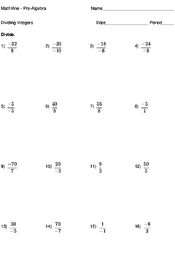Dividing Integers
Introduction
Dividing two integers means finding out how many times the second number goes into the first. For example, 2 goes into 12 6 times, so:
If you are working with negative numbers or a mixture of negatives and positives, it becomes a little trickier, but still follows the same principles.
Terms
Lesson
How you divide numbers depends on whether the numbers are positive, negative, or a combination of the two.
Dividing positives
If you divide two positives, you find out how many times the second number goes into the first. For a very simple method, just subtract the second number from the first, then repeat, counting how many times you do it until the number reaches 0, or can't be reduced any further.
For example:
Since we did that three times, 15 ÷ 5 must be 3.
Another way to think about it is to do your times tables in reverse.
So when you see the equation:
You can reverse the equation to say 6 x ? = 18.
If you know your multiplication tables, you know what 6 x 3 = 18, and therefore 18 ÷ 6 = 3.
Multiplying negatives
If you have an equation with two negatives, they cancel one another out. Two negatives divided by one another is the same as two positives divided by one another.
For example:
If you have an equation with an odd number of negatives, then the answer will be negative. If you have an equation with an even number of negatives, the answer will be positive. For example:
(positive)
(negative)
Multiplying mixed equations
If you have equations with a mixture of negatives and positives, the key factor is how many negatives you have. If you have an odd number of negatives, the solution will be negative. If you have an even number of negatives the solution will be positive.
For example:
(negative)
(positive)


